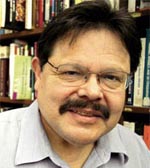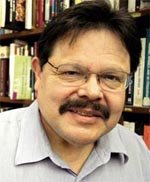INNOVATIVE TEACHING SHOWCASE
Collaborating Across Differences
Teaching in the Post 9/11 Era
of cultural understanding we
have the social obligation to
take the initiative in educating
our students as to the
complexities and responsibilities
of being a global citizens."
— Dr. Larry Estrada
Photo credit: Chris Huber
The post 9/11 era has changed the social and cultural landscape of the United States. Fear of the "other" and the creation of new social binaries provide us with increased challenges as we attempt to equip our students to deal with an increasingly globalized world and the many conflicts and contradictions that they will find in their own personal social contexts.
According to the Southern Poverty Law Center's Intelligence Report, during the post 9/11 era there has been a marked increase in hate groups and negative sentiment towards Arab Americans, Muslim and Middle Eastern populations. This is coupled with the rise of anti-Latino sentiment brought on by the magnified focus of the U.S. government and American public on immigration issues. The growth of hate groups also indicates more subtle shifts within the greater population in terms of attitudes toward different cultural and ethnic population groups. Ethnic jokes, jibes and outright verbal and physical abuse of ethnic and international students have been reported on several campuses during the past few years.
As academics we often believe that our students and colleagues represent the most reasoned and conscientious elements of society. Even though the academy allows us special privileges to openly discuss issues of social import , we still must actively engage our students in ways that promote greater interaction and understanding of different cultural and societal values.
As practitioners in the field of cultural understanding we have the social obligation to take the initiative in educating our students as to the complexities and responsibilities of being global citizens. Harvard historian, Samuel Huntington, once stated that the "fundamental source of conflict in this new world and millennium will not be primarily ideological or primarily economic. The great divisions among humankind and the dominating source of conflict will be cultural."
Teaching Strategies
As a teaching member of the Fairhaven College commmunity and as Director of American Cultural Studies, I have combined many elements of traditional instruction with those that stress individual inquiry, group interaction, students' engagement with each other and a sense of a learning community that builds on mutual respect and inquiry. To accomplish this I use several instructional techniques which bring students together to focus on common issues and problems, thus allowing them to voice respectful dissent with one another, and which employ students as instructional components and co-teachers within the classroom process.
Due to the fact that many of my courses deal with historical and cultural content and focus on diversity within American society, I tend to employ several methods to convey course content and material. The majority of my courses use a mixture of traditional lectures mixed with breakout student discussion sections, small group discussions, ethnographic interviews, perspective papers, the development of a written "group term project paper", as well as culminating group oral presentations which students give to their fellow classmates. These presentations are predicated upon the research and data gleaned from their written project papers.
Depending on class size and content, I may also employ the use of midterms and take home finals for some of my cross-listed courses. Questions on these examinations are given ahead of time, which allows for group study and discussion. My teaching strategy is designed to fully engage students within the class while creating mini learning communities, where group dialogue and decision-making can take place. These strategies allow me to establish a base of information to students, while allowing them to grapple with competing ideas and concepts.
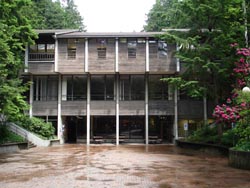
University, Bellingham, Washington
Photo credit: Paul Edgeman
Over the course of my teaching career on the main WWU campus and at Fairhaven College, my highest marks as an instructor (as indicated by student feedback and evaluations) have been achieved when students have worked in teams as co-learners (see Group Term Project in my American Cultural Studies 301 syllabus). My tendency to create a cooperative environment for learning is not only rooted in the philosophy of Fairhaven College, but goes to the root of who I am as a member of an ethnic minority group and my own beliefs as to how students best learn and interact with each other. It is also rooted within Freirian methodology, which prompts students to achieve understanding and meaning through the process of conscientization. This process requires students to reach a critical self-examining state-of-being that includes the moral, social, political and cultural contexts of their own education (see Ethnographic Interview).
Although by no means perfected and at times designed to allow for disagreement and debate among students, the teaching strategies that I have employed have allowed Fairhaven and non-Fairhaven students, majority group and ethnic minority group students to mutually engage in discourse as well as participate within constructive, creative and jointly designed endeavors. Given the general content of my classes that often deal with racial, ethnic, gender and class conflict, I find that collaborative learning strategies are essential for successful learning outcomes and student collegiality.
Over the years students have thanked me for allowing them to learn in a cooperative, not competitive, setting. A number of students who initially collaborate on their course project will also take on issues and concerns that affect them in their general environment. A sizable segment of co-learners have felt the need to go on to collectively address social change both on campus and within the greater community.
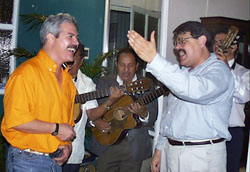
Morelia and Oaxaca, Mexico for his
Contemporary Cultures of Mexico Class
Photo provided by Dr. Estrada
Collaborative learning also allows students with different levels of proficiency and skills to rely on one another's strengths. Co-learning in this respect enables students to evaluate their own abilities while assisting and supporting others in finishing and presenting their group term projects. Throughout this process students also learn about each other's backgrounds, values and perspectives.
In conjunction with collaborative learning I have also endeavored to extend learning outside the classroom context to enable students to directly apply their knowledge to real social and environmental settings. In many of my courses students, through field trips and visits, are introduced for the first time to such community contexts and agencies as the Northwest Indian College, the Bellingham School District, ESD 187 Migrant Educational Center, Lummi School, Latinofest, SeaMar Health Clinic, Centro de La Raza in Seattle, Migrant camps in Skagit and Whatcom Counties, and even the old growth forest within Whatcom County. Exposure to these agencies and contexts familiarizes students with many of the issues and problems that receive little mention in texts or media and which are often not covered in their other academic courses.
Curricula is also expanded by the collective expertise and wisdom which students receive from community educators, social and health workers, conservation activists as well as common citizens who are able to relay their own points of view and concerns while fielding questions and queries directly from the students. Such exposure also provides a means for many students to arrive at future ISP's, service learning projects, or volunteer work that can frame an invaluable part of their over all learning experience. Several students who I have advised have utilized their initial familiarity with community agencies and outlets to later frame their own internship opportunities and senior projects.
International Courses
Along with teaching core courses within Fairhaven College I have also introduced a number of courses dealing with diversity and Mexican culture and society that have allowed students a greater breadth of curricular choices both within and outside of the College. Many of my Fairhaven courses are recommended to students by faculty in the Departments of English, Anthropology, Sociology, Foreign Languages, Women Studies and the Woodring College of Education.
international travel and study
abroad were indispensable mediums
by which to expand students'
comprehension and vision of their
own place and connection to a
global community."
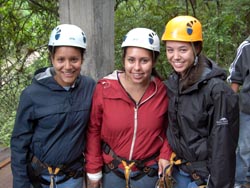
Contemporary Cultures of Mexico course
Photo credit: Sierra Schraf-Thomas
Together with local opportunities and connections to community resources, I have always felt that international travel and study abroad were indispensable mediums by which to expand students' comprehension and vision of their own place and connection to a global community. For this reason I initially created FAIR-310-V, Contemporary Cultures of Mexico (See Contemporary Culture of Mexico [PDF] Brochure). The course is designed to provide students with the opportunity to travel and study in central Mexico while learning about the historical, cultural, social and political dynamics which presently impact Mexican society. The course features intensive language instruction while matching students up with home stays and providing field trip opportunities to understand the complexities of Mexico's Mesoamerican past and present. Content of the course ranges from topics on immigration, economic sustainability, and utilization of indigenous, traditional medicine. Over the past few years I have taken nearly 90 students, the majority of whom have been Fairhaven students, to central and southern Mexico. As part of their self-evaluation of the class the 2001 group produced a video as well as a CD that chronicled their experiences and insights while in Mexico. This was presented to an all university audience complete with a "Mexican fiesta" winter quarter of 2004.
Future Goals
Europeans have sought out indigenous,
traditional healers for their curative and
spiritual powers."
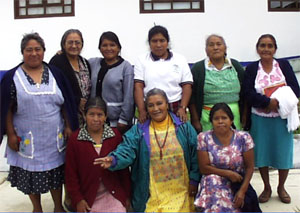
Photo credit: Dr. Estrada
I plan to continue my on-going research on curanderismo (the Latin American tradition of folk healing by spiritual leaders) specifically focusing on curanderas and traditional medicine within the Michoac�n and Oaxaca regions of Mexico. Currently, hospitals and health agencies in several parts of the Southwest including major hospitals in San Francisco and Los Angeles have hired curanderas and curanderos to interact on a daily basis with modern health practitioners and doctors to assist the holistic needs of their patients. Increasingly, Americans as well as Europeans have sought out indigenous, traditional healers for their curative and spiritual powers. Many curanderas in Oaxaca are treating patients and clients who are coming directly from Europe and the United States to receive herbal, massage, and even spiritual treatments.
My interest is primarily focused on what impact this increased attention and utilization of traditional healers will have upon the personal lives of curanderas and in turn how it will affect the cultural and social contexts of communities and policy governing traditional medicine in these areas. These areas also augment the teaching I do in Mexico and at WWU on courses that deal with Mexican culture and society.
I also plan on extending my research that examines the role of ethnic and American Cultural Studies in light of the phenomenon of globalization and American global influence. In many respects the study of ethnic groups in the United States has also provided a template for academics internationally to look at the socio-politico intersections of class and ethnicity within their respective nations and communities. I firmly believe that comparative examination of ethnic and cultural issues will allow us to foster new approaches and lenses by which to critically inquire into the social forces and dynamics that affect all of us as a global society.
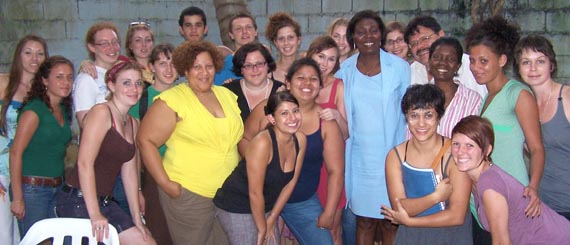
↑ Go to top

